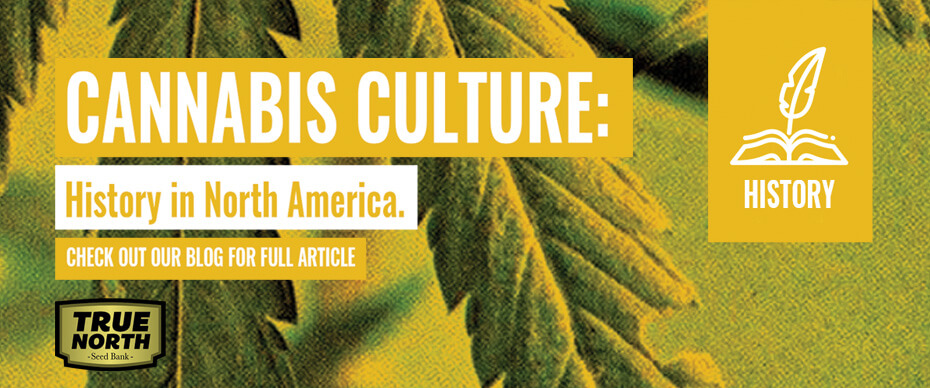
For hundreds of years, cannabis was seen as a desirable plant for its usefulness in fabric production and many other practical applications.
Cannabis may have been first introduced in North America by the Spanish in the 1500s. Early cannabis cultivation provided fibers for making paper, rope, & numerous other products. Until the end of the 1800s, colonies were unaware of cannabis’s psychoactive properties.
Let’s dive in and explore cannabis culture history in North America.
Colonial Era: The Beginning Of Cannabis Culture In North America
Some scholars believe that the Spanish have been credited with the introduction of cannabis cultivation in the 1500s.
Towards the beginning of the 1800s, the Legislative Assembly of Upper Canada established a grant of 300 pounds for hemp-processing machines.
Until the end of the 1800s, most of the population were completely unaware of the psychoactive properties of cannabis.
Even though most people didn’t know about the psychoactivity, cannabis was extensively cultivated in the continent of North America for cordage use as a fiber.
However, even as late as the early 1890s, physicians were still recommending its use for various neuralgias.
Not long after, Congress began regarding cannabis as a drug and began making false claims about the “risks” of a drug overdose and addiction.
With the aggressive false claims continually repeated by the leaders of America, the first to make cannabis illegal was the state of California.
During the process of cannabis becoming completely illegal, the prominence of cannabis started taking root due to the influx of Mexican immigrants to the US during the 1920s.
Due to medical authorities identified cannabis as a narcotic, at the end of the nineteenth century, the declarations of support for the Marijuana Tax Act of 1937 and the Narcotics Control Act of Canada, was endorsed by the medical field.
The U.S. Food and Drug Administration (FDA) finally prohibited further experimentation on the medicinal effects of the drug in 1937.
In 1938, the federal government prohibited the development of narcotics under the Opium and Narcotics Act Before the 1900s, including cannabis.
As laws started solidifying all across North America, in the early part of the 20th century, cannabis use was falsely believed to be as bad (or worse) than heroin.
The End Of An Era: Cannabis Criminalization
The beatnik and hippie movement started in the late 1950s and picked up where the Swing Music of the 1920s left off when it came to the criminalization of cannabis.
This movement was conducted in line with the current drug policy of never ever-changing regulations, which were not yet repealed.
A year after the stock market crash, the Volstead Act was repealed, a second new ban began during the worst parts of the 1930s.
So the story goes, during this time, cannabis use was especially prevalent among Mexican and African Americans and less common among Caucasian people.
Since society had already protested its use, the usage of cannabis was banned because of an already existing complaint in the country.
In 1931, 28 states established prohibitions on the sale of cannabis, and in response to this suit was enacted by 1938, there was the Marijuana Tax Act.
Despite several revisions, lawmakers continue to focus their policy on prior laws that are concerned with specific substances, or their fads, when it comes to drugs to legislation.
People who are in support of lighter regulation caused a bit of a back and forth on the topic of fines and other harsher penalties.
1970: The Start Of Cannabis Decriminalization
In 1970, the attempts to repeal most of the criminal penalties for cannabis crimes were starting to become acceptable.
Most of the criminal sentences for drug-related crimes of cannabis were being abolished by Congress.
The claims were the harsh mandatory penalties had done little to break the 60s-era drug epidemic where cannabis was widely embraced.
Shafer Commission was appointed by Nixon at the behest of Congress and tasked with investigating cannabis policies.
What the commission concluded was personal use should be decriminalized.
Nixon ignored the proposal, but over the course of the 1970s, eleven states revised their criminal sentences.
In 1973, the establishment of the U.S. Drug Enforcement Administration (DEA) and began enforcing federal drug laws.
As the DEA continued taking root, a nation-wide movement emerged from conservative parents against the use of cannabis.
Conservative parents protested for stricter measures to prevent drug use among teenagers.
In 1976, their campaign became strong enough to obtain the support of the DEA and the National Institute on Alcohol Abuse (NIAA).
Campaigns led by various federal agencies had a profound effect on public opinion of cannabis and other drugs, leading to the '80s anti-drug campaign.
President Reagan signed the Anti-Drug Abuse Act, making drug offenses illegal.
Due to the Comprehensive Crime Control Act of 1984, the revised penalty schemes increased criminal penalties for both possession and distribution of cannabis.
Increased penalties treated 100 cannabis plants the same as 100 grams of heroin.
On national television, President George Bush announced a new war on drugs in 1989.
Finally, with all the volatility in cannabis policy happening at the federal level, California decided to spearhead the passage of Proposition 215 in California with voters giving their blessing to the legal sale and medicinal use of cannabis.
This legislation contradicted federal laws banning the possession of cannabis in the U.S., thus California bravely set a precedent for standing up to the U.S. federal government’s poor treatment of cannabis laws.
New Era: Of Cannabis Culture In North America
After California courageously made its stances, many other states and countries began upgrading their bad cannabis laws.
Decriminalization and legalization even still continued throughout the 2020 elections, with more expectations of legalization in 2021 and beyond.
The people in New Jersey and Arizona opted to legalize the use of cannabis.
Voters in the state of Mississippi authorized the use of medical cannabis.
Furthermore, it’s worthy to note, all things considered, the real winner of the 2021 election is cannabis.
With the way legalization is sweeping the nation, several U.S. states already allow the use of cannabis for adult recreational purposes, including the District of Columbia.
What’s interesting is how Washington DC can legalize recreational cannabis, yet, still, maintain its illegal status at the federal level.
Thirty-six states have legalized medical cannabis use of the drug. More broadly, except for Idaho, Kansas, Tennessee, and Alabama, decriminalization laws are found in every state.
For around a month after the referendum, the Democratic-controlled House of Representatives had passed the M.O.R.E. Act (Marijuana Opportunity Reinvestment and Expurgent Act).
With the passing of the MORE Act, the law will make the use of cannabis federal with states having the ultimate authority to regulate their own local laws.
All in all. It appears that cannabis is a bipartisan topic in the US right making fast strides towards full legalization, leading to a national trend with the approaching creation of national cannabis culture.

About the author: Joe Powers
After an incident in the military, in 2011, Joe Powers began investigating cannabis by talking with industry leaders. In 2016, Joe launched Hemp Writer with its first publication in clarifying disinformation on specific updates to certain federal CBD laws.
Upon calling out a leading cannabis law firm spreading dis-info, Hemp Writer established itself as an authority in clarifying updated information emerging from the cannabis industry. Joe continues charging forwards with increasing momentum to continue fulfilling his vision of SHARING ACCURATE CANNABIS INFORMATION.










